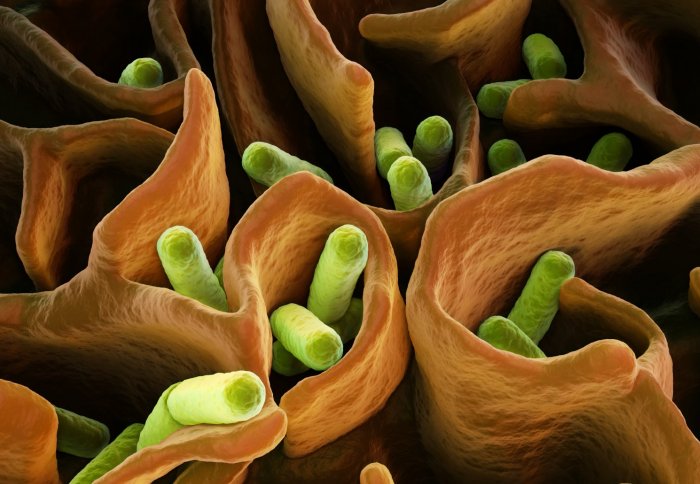
E.coli bacterial colony

Scientists have gained the first structural insights into the warfare that takes place when bacteria are starved of nutrients.
The new discovery could help develop new approaches to tackling bacterial infections, as researchers hope they could harness bacteria’s destructive capabilities. With an estimated 25,000 patients dying each year from infections caused by antimicrobial resistant bacteria, alternatives are needed to traditional antibiotics made from purely synthetic compounds.
Certain bacteria produce antimicrobial lasso peptides, which have a unique knotted structure. The bacteria that produce these lasso peptides have an advantage over other bacteria, since the peptides enable them to kill neighbouring bacteria for more nutrients. When the peptides come face-to-face with receptors at the outer membranes of other bacterial cells these peptides can hijack the receptor for nutrients and kill the target bacteria.
“Successfully treating infectious diseases is currently a huge challenge as bacteria are so good at shrugging off existing antibiotics by developing resistance to them. The structural studies we carried out at Diamond are very exciting [because it]leads us to believe the peptide could act as a platform for new drugs against bacterial infection.”
– Dr Konstantinos Beis
Department of Life Sciences
Until now, scientists knew little about how this interaction unfolded. To uncover the bacterial war tactics, scientists used structural data collected on the crystallography beamlines at Diamond Light Source, the UK’s national synchrotron science facility, combined with modelling and biochemical experiments. The team brought together scientists from Imperial College London, the Muséum National d’Histoire Naturelle in Paris and the University of Oxford, and their results have been published this month in Nature Chemical Biology. The researchers focused on E.coli bacteria.
Konstantinos Beis, from the Department of Life Sciences at Imperial College London, comments, “Successfully treating infectious diseases is currently a huge challenge as bacteria are so good at shrugging off existing antibiotics by developing resistance to them. The structural studies we carried out at Diamond are very exciting as we have identified a key residue in this particular peptide that is important for the recognition of the E. coli receptor and this detailed knowledge, coupled with the fact it has a very stable lasso structure, leads us to believe the peptide could act as a platform for new drugs against bacterial infection.”
The scientists found that battle lines are drawn when the E. coli bacteria are starved of iron and seek it out via iron receptors on their outer membrane. These receptors are important and help bacteria to track down iron, but covert operations come into force as the lasso peptides hijack these receptors for their own purposes and kill the bacteria in the process. Such clashes between bacteria could prove very useful to humans in our fight against bacterial infections.
Sylvie Rebuffat, from the Muséum National d’Histoire Naturelle-CNRS in Paris, adds “My team has been working on this particular peptide for over a decade now and, while these are early stage results, they provide the structural information that we have been waiting for to enable us to establish it as a front runner to aid in the design of new medicine to fight bacterial infections.”
The research was funded by the Medical Research Council, the Wellcome Trust and the Biotechnology and Biological Sciences Research Council.
REFERENCE
Mathavan, I et al. ‘Structural basis for hijacking siderophore receptors by antimicrobial lasso peptides’ Nature Chemical Biology, 6 April 2014.
Supporters



Article text (excluding photos or graphics) © Imperial College London.
Photos and graphics subject to third party copyright used with permission or © Imperial College London.
Reporter
Gail Wilson
Communications and Public Affairs

Contact details
Email: press.office@imperial.ac.uk
Show all stories by this author




Leave a comment
Your comment may be published, displaying your name as you provide it, unless you request otherwise. Your contact details will never be published.